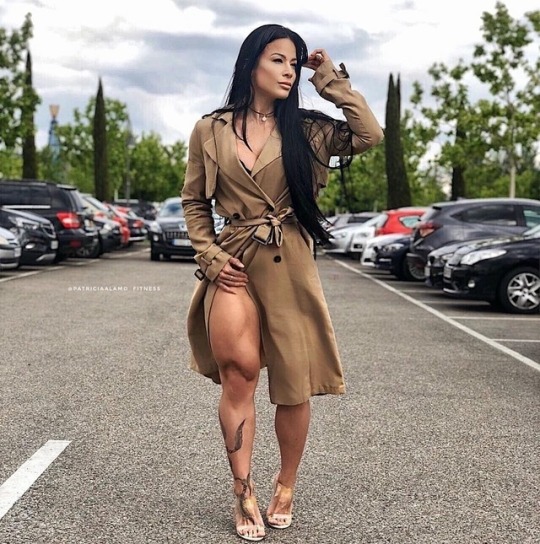#Patricia Alamo
Text
Patricia Alamo

129 notes
·
View notes
Text

Patricia Alamo
#women with muscles#women flexing#arm flex#girls with muscles#muscular women#patricia alamo#women with tattoos
538 notes
·
View notes
Text
instagram
2 notes
·
View notes
Video
Female Fitness Motivation - Patricia Alamo AKA patriciaalamo_fitness
#youtube#female bodybuilders#patriciaalamo_fitness#Patricia Alamo#girls who lift#bodybuilding#female workout
22 notes
·
View notes
Text
'Lilli Schwenk Hornig was 23 years old when she arrived at Los Alamos to contribute to the development of an atomic bomb that would end World War II. A passionate chemist, Lilli battled sexism throughout her academic and professional careers and remained a steadfast advocate for female scientists like herself.
Lilli Hornig: What I remember in my mind is the—these sort of boiling clouds and color—vivid colors like violet, purple, orange, yellow, red, just everything. And we were all kind of shaken up.
Katie Hafner: That’s the scientist Lilli Hornig, describing what she recalls of the first test of a nuclear bomb on 16 July 1945 in the New Mexico desert.
This is Lost Women of the Manhattan Project, a special series of Lost Women of Science focusing on the female scientists and their contributions to the building of the first atomic bomb.
In this episode, we share the story of a young chemist who experienced Nazism firsthand in Europe before finding herself in the middle of the United States’ war against Hitler, working against time to develop the detonating device that would make the Trinity test possible. After that test, and the bombs themselves that were dropped on Japan, she was shaken, and haunted.
We also want to tell you Lilli Hornig’s story because she's an example of something we keep seeing over and over at Lost Women of Science: female scientists who follow their scientist husbands to new jobs in academe or industry. The Manhattan Project scooped up many of these spouses though it’s impossible to put a number on just how many.
And there’s more about Lilli Hornig: she’s the only female scientist named in Oppenheimer, Christopher Nolan’s blockbuster film. Her cameo appearance isn’t far off the mark. She’s shown as a woman determined to work as a chemist, not a secretary.
In 2011, the year she turned 90, the real Lilli Hornig sat down for an oral history interview with the Atomic Heritage Foundation. The audio you’ll hear from that conversation is a little bit scratchy, and although Hornig is still as sharp as can be, it’s clear that she’s, well, 90.
Producer Mackenzie Tatananni brings us Lilli Hornig’s story.
Mackenzie Tatananni: Lilli Schwenk was born on March 22, 1921, to Jewish parents in a tiny Czech town about 50 miles outside of Prague. Her father was an organic chemist, her mother a pediatrician. Lilli was introduced to science during her formative years, and the interest stuck.
Hornig: My father took me occasionally, very occasionally, on a Sunday to his lab, and I just loved all the glassware, and he gave me some micro-sized glassware for my doll house. So, I always assumed I would be either a chemist or a physician. And I was kind of squeamish at the time, so I went for chemistry.
Tatananni: In 1929, when Lilli was eight years old, she moved with her family to Berlin, where her father began work for a pharmaceutical company. But anti-semitism was on the rise and the Nazis were establishing a stronghold throughout Germany. The danger to the Schwenk family was palpable.
Hornig: After Hitler came to power, my father was actually being threatened with being taken off to a concentration camp.
Tatananni: Fearing for his life, her father fled alone to the United States in 1933. It would be months before Lilli and her mother were able to join him, settling in Montclair, New Jersey.
The U.S. was a daunting new world for Lilli. She barely spoke English. School was the biggest shock of all. Everything was unfamiliar, from the placement tests she took at the start to the creamed carrots she prepared in cooking class.
But she wasn’t deterred. Lilli earned a B.A. in chemistry from Bryn Mawr in 1942 before moving on to a graduate chemistry program at Harvard. Unlike Bryn Mawr, a women’s college, Harvard’s chemistry department was far from inviting for women. For one thing, there was no ladies’ room in the building.
Hornig: I had to go to another building. I had to get a key for it. And that sort of gave me a message.
Tatananni: At a meeting with chemistry faculty, she was told that women always had trouble with physical chemistry. Lilli did NOT want to prove them right. She studied rigorously, poring over the notes of fellow chemist Donald Hornig, a PhD student whom she’d met on her first day and soon began dating. But she flunked the first semester and was forced to retake it, only to ace it the second time around.
In spite of these trials, she earned her master's in chemistry in 1943, the same year she married Don Hornig. Don was already involved in the effort to develop nuclear weapons. His doctoral thesis investigated blast measurement, and he was studying ways to measure blasts in midair.
In 1944, Don was approached by his thesis advisor, Bright Wilson, with a job offer. But he wouldn’t elaborate on just what the job would be.
Hornig: Bright said, “Well I can’t tell you much about it.”
And Don said, “Well tell me where it is.”
And he said, “No I can’t tell you.”
“Well, can you at least tell me, is it north, south, west?”
“No, couldn’t tell you.”
Tatananni: Don relayed what little information he had to Lilli. The job offer was shrouded in so much mystery that they jointly decided that Don would turn it down. However, Don continued to face pressure, particularly from George Kistiakowsky, a physical chemist who had gone to Los Alamos to develop explosives. Kistiakowsky called Don and told him he needed him badly.
Hornig: And with a few curses, which was very much his style—he said, “Dammit, you come out here.”
Tatananni: Kistiakowsky managed to talk Don into taking the job. But–
Hornig: I said, “What am I going to do there?”
And so Don talked to George some more, and after that George said, “Oh we’re scouring the country for anybody with a Master’s in chemistry, especially from Harvard, is going to be more than welcome.”
Tatananni: She was in. They were both 23.
Hornig: You know we were so young. When I look now at our grandchildren, the youngest ones are about the age we were then and they don’t think of themselves as having adult responsibilities. It’s very striking to me because we had no doubt that we were grown up.
That spring, the couple sold their Massachusetts home and their sailboat, bought a 1937 Ford Coupe and drove to Los Alamos, New Mexico.
When they arrived…Don went straight to work…
Hornig: And I went to the personnel office. And the first question was, “How fast can you type?” And I said, “I don’t type.”
Tatananni: We see a version of this scene in the film Oppenheimer. The character Lilli Hornig catches up with Oppenheimer as he’s walking with a group of men.
[Start clip from the film Oppenheimer]
Hornig: Dr. Oppenheimer, I tried personnel. They asked if I could type.
J. Robert Oppenheimer: Can you?
Hornig: Harvard forgot to teach that on the graduate chemistry course.
[End clip from the film Oppenheimer]
Tatananni: Oppenheimer turns to one of his scientists and says, "Put Mrs. Hornig on the plutonium team.
She started with the plutonium group as soon as her security clearance came through, and she quickly found that her new life was…lonely.
Ellen McGehee: She did not have children. She was even more isolated from her, sort of female peers, because she kind of worked within her own group and socialized with her husband's friends and those couples.
Tatananni: That’s Ellen McGehee, a lab historian at the Los Alamos National Laboratory who has researched the life of Lilli Hornig.
McGehee: I sense that she had almost a, she had a pretty compartmentalized scientific experience. Even though she knew what the goal was.
Tatananni: Here’s how Lilli saw it:
Hornig: There was one other woman in the division, she and I worked together, and we had our little cubby hole and did our little procedures and put them under the geiger counter. And nobody actually really spoke to us.
Tatananni: Plutonium chemistry was a mystery at the time, as almost none of the artificial element had been created. Lilli’s group was working on studying plutonium-239, the isotope that was believed to be a powerful fuel for the atomic bomb. However, in the summer of 1944, there was a disappointing discovery. It turned out that using plutonium in a bomb would be harder than expected. Los Alamos scientists found that plutonium created in a nuclear reactor contained traces of the isotope plutonium-240, which is formed when plutonium-239 absorbs another neutron while still inside the reactor. Plutonium-240 had an extremely high rate of spontaneous fission, and could not be removed from the valuable plutonium-239. While uranium could be used in a very simple bomb design, a plutonium bomb made that way would prematurely detonate, destroying itself before its reaction got large-enough to be a viable weapon.
So the Los Alamos scientists had to pivot. And quickly.
At that time, most of the work at Los Alamos had been focused on a simple bomb design called the gun-type, in which one piece of fissile material was shot into another through a gun tube. The plutonium gun design, called Thin Man, was discontinued when it was discovered that it would pre-detonate. The scientists understood that to use plutonium in an atomic bomb, they would need to do something different.
They decided to focus on implosion, a much faster method of assembly. A sphere of plutonium would be surrounded by tons of specially-designed high explosives, detonated at exactly the same moment and potentially leading to a powerful and efficient explosion. But nothing like implosion had ever been done before. The entire organization of Los Alamos was shifted in the summer of 1944 to tackle and solve the implosion problem.
When that happened, both Lilli and the other woman were taken off work that directly involved plutonium. The men in charge were concerned that radioactive materials would affect fertility. This scene also appears in the Oppenheimer movie, but don’t blink or you’ll miss it. In case you did miss it, here’s how Lilli described her reaction to the men's concern for her health:
Hornig: They were worried obviously about reproductive damage. I tried delicately to point out that they might be more susceptible than I was; that didn’t go over well.
Tatananni: Lilli went on to join her husband in the high explosives unit. The need for precision in the explosives and their detonators was unprecedented, and that unit proved crucial to the success of the new plutonium bomb, which was codenamed Fat Man.
Here's Ellen McGehee, the Los Alamos historian, again:
McGehee: They really needed to figure out how implosion was working. And so they had to come up with all these different methods and new technologies that had to be invented on the spot and facilities that actually had to be built.
Tatananni: Lilli’s group worked on the explosive lenses used in Fat Man to focus the implosion shockwave and guarantee that pressure was uniform around the plutonium core. But just two days before the Trinity test, there was a misfire on the spark gap switch, a sensitive electronic device that Don had designed to send an electrical signal to all 32 of the lens detonators within a microsecond.
Hornig: And at two o’clock in the morning our group leader Lewis Fussell was knocking on my bedroom window saying, “You have to get up, we have some work to do.”
Tatananni: So Hornig and Fussell headed to the stock room with a list of equipment they had to replace. In a matter of hours, they located the parts, which were shipped off on a truck that same morning.
Forty eight hours later, Lilli was sitting atop a mountain in the Sandia range with colleagues, 110 miles from the test site, watching and waiting for ignition.
Hornig: We put sleeping bags on the ground. None of us slept very well, so we got up about three o'clock, I guess. And started waiting for the shock, kept keeping our eyes glued on, on the site.
Tatananni: They waited and waited, but nothing happened. They decided the test wasn't happening that day after all, and started to leave.
Hornig: I was sitting in the car reaching for my ignition key—and the thing bloomed in front of us and it was just incredible.
Tatananni: It didn’t take long for Lilli and her colleagues to understand in the most concrete of terms the potential for destruction on an unprecedented scale.
Germany had surrendered two months earlier, in May of 1945, so the war in Europe was over, but it raged on in the Pacific as Japan refused to surrender.
Lilli – and many others working on the Manhattan Project – had been in favor of building a bomb to stop the Nazis, especially if the Germans were working on one as well. But once Germany surrendered, and …
Hornig: Once the European war was over with, well, a lot of people left right away.
Tatananni: There was now a question about whether it was really necessary to drop the bomb on Japan.
Leo Szilard, a physicist working with Enrico Fermi’s group in Chicago, circulated a petition among the scientists there that called on President Truman to consider dropping the bomb only if an announcement was made first and Japan still refused to surrender.
Hornig: I remember the petition came around just after the test. Some of my friends were signing it and I thought about it and I thought that was a good idea.
We thought in our innocence that if we petitioned hard enough, they might do a demonstration test, and invite the Japanese to witness it. But of course the military I think had made the decision well before that they were going to use it no matter what. And so we had very mixed feelings about that.
Tatananni: In the end, Lilli wasn’t one of the 70 scientists who signed the petition - although she appears in the movie, speaking out against the dropping of the bomb. And she wasn’t at Los Alamos when the Americans dropped the first atomic bomb on Japan. She was in Milwaukee, visiting her in-laws.
Hornig: We knew the drop was imminent. We didn’t know the precise moment. Certainly Don’s parents didn’t have TV at the time and I don’t know if there were ever any news on, but Don and I went downtown. There were all the papers with the headlines, so we knew it had gone off.
That was an odd mix of feelings. I mean, certainly some triumph and the destruction was just so incredible. I think we’ve all been a little haunted by that over the years.
Tatananni: Shortly afterwards, Lilli fell ill with hepatitis and couldn’t return to Los Alamos. So she returned to her studies. Again she followed her husband, this time to Brown University, where she was offered lab space, all while commuting to Harvard to attend lectures.
In 1947, when Brown found itself short on chemistry faculty, Lilli stepped up to teach.
Hornig: And it was very hard to hire faculty then because there were so many guys coming back, making huge classes, and you know with that many men graduating or getting their graduate degrees during the war. Here I was with a brand new baby, with a Master’s Degree, teaching 250 guys, and I think there were six girls in the first class.
Tatananni: Lilli received her doctorate in chemistry from Harvard in 1950, and no, typing wasn’t taught in the doctoral program there, either. She continued teaching at Brown and later at Trinity College as chair of the chemistry department.
She became an outspoken champion of women in science, paying forward the hard-won role she played during a pivotal time in U.S. history. It’s hard to say what Lilli would have thought of the film in which she appears as the only female scientist. Chances are she’d have been amused, perhaps even honored. Then again, she might have been pissed off on behalf of all the women who were left out, not just of that movie, but left out of a history rich with the stories of hundreds of female scientists like her.
Tatananni: Lilli Hornig died in Rhode Island in 2017 at the age of 96.
Hafner: This has been Lost Women of the Manhattan Project. Mackenzie Tatananni produced this episode with help from Deborah Unger and from me, Katie Hafner...
Thanks, too, to Alex Wellerstein, John Townsend, the physics department of Harvey Mudd College and the American Institute of Physics for helping us get the science straight.
Those excerpts you heard from the Lilli Hornig interview were used with permission from the Atomic Heritage Foundation and the National Museum of Nuclear Science & History.
Lost Women of Science is funded in part by the Alfred P. Sloan Foundation and Schmidt Futures. We’re distributed by PRX and produced in partnership with Scientific American.
For more about Lost Women of Science, please visit us at lostwomenofscience.org...
Hafner: A special shout-out to the folks at Los Alamos National Laboratory for helping us tell the stories of the women who worked on the Manhattan Project.
We can’t tell you all their stories, but we can tell you many of their names, which we’ve been reading aloud for you on and off through this series. Here are a few more….
Speaker: Pat Patterson.
Speaker: Hazel Genzel.
Speaker: Ida Cunningham.
Speaker: Joan Clark.
Speaker: Amanda Bloom.
Speaker: Kathleen Gavin.
Speaker: Mary Rose Ford.
Speaker: Gladys Morgan Hopper.
Speaker: Creola Green McCamey
Speaker: Patricia Lear.
Speaker: Doris Dixon.
Speaker: Sonia Katz...'
#Joan Clark#Amanda Bloom#Kathleen Gavin#Mary Rose Ford#Gladys Morgan Hopper#Creola Green McCamey#Patricia Lear#Doris Dixon#Sonia Katz#The Manhattan Project#Los Alamos#Pat Patterson#Hazel Genzel#Ida Cunningham#Lilli Hornig#Christopher Nolan#Harvard#George Kistiakowsky#Ellen McGehee#Enrico Fermi#Leo Szilard
0 notes
Text
more GTA quotes and facts derived from the audio PART 4
Trevor is willing to shit in plastic baggies if pressed for time
Michael respects Chef and likes working with him
Chef likely dresses/cleans/prepares Trevor's human meat. Maybe also partakes.
"You gonna eat what you kill?" Chef if you start killing hostages
Chef smokes crank before a heist
Trevor can take Packie to the cannibal cult
Women arent permitted on the los santos golf course
Trevor wanted to be an artist or a musician when he grew up. (Or an arms dealer/drug runner but im pretty sure that quote is just him trying to make a point lol)
"This is our alamo" michael during the paleto score
"Sweet mother of me" -trevor
When the 2 drunk estranged old friends, (one single, the other married with kids) are arguing outside the bar Trevor yells "will you two just make-out already"
"Ohhh, thats it little man. Sing me a rainbow" trevor when drunk single guy barfs in his car
"How bout i suck those kidney stones right outta your balls, big guy? Get this party really started" - Trevor
"Michael. With one L. Because thats how its spelt"
"Power to ya, sister. Screw the nuclear family" trevor to the runaway bride
Michael calling baby boomers "the worst generation ever" and getting highly offended when not recognized as a Gen Xer
"Shrink says i have a hero complex" -Trevor
"Do you think Patricia would like those heels? Her legs.. mmm.. beautiful anyway" "Keep your mind on the job. Not your mother substitute hostage."
70 notes
·
View notes
Video
vimeo
ASUS - Reuben Wu from anna smoronova on Vimeo.
starring
Reuben Wu
Zachary Henderson
Illustrator: Kveta Kubus
Client
Looping Group
ASUS
Client: Looping Group
Managing Director: Christian Polman
Account Manager: Emily Maitland
Senior Director Strategy: Erminia Blackden
CCO: Dominik Anweiler
Executive Creative Director: Richard Gostelow
Creative Director: Lukas Palm, Friederike Hamann
Senior Creative Producer: Dennis Hölter, Christian Müller, David Osterkorn
Art Director: Kalle Haasum, Jan Volpp, Niklas Hail, Franziska Stegemann
Junior AD: David Starosciak, Nadeen Al Attar
a modest dept. production
Director: Maros Milčík
DoP: Anna Smoroňová
Photographer: Thomas Van Kristen
BTS: Zhana Yordanova
Executive Producer: Johannes Lehmann, Gerrit Piechowski
Head of Production: Benedikt Merten
Producer: Brian Papish
Production Assistant: Marleen Nesner
Service Production: VOLCANO Films
Local Producer: Sebastián Alvarez
Local Production Manager: Alejandro Alamo
1st Production Assistant: Patricia C. Barandalla
Location Manager: Diego Durán
Location Assistant: Ruben Diaz
Production Assistant: Aday Ayala, Samuel Perez
Production Team: Suong Nguyen, Mattia Zangrando, Nicole Stewart, Ian Stewart, Javier Cruz, Aday Gonzalez, Toni Arbelo, Luis Alvarez
1st Assistant Director: Oscar Santamaria
Art Director: Marta Torrecilla
Art Assist: Jonay P. Matos
Product Care: Marleen Nesner
Product IT: Eric Jordan
SFX: Santiago García, Juanal Donaire
Stylist: Lauro Samblás
Costume Assist: Cris León
Make-up: Sara Luna
1st AC: Charly de Croix
Focus Puller: Guillermo Gil
DIT: Chemi Ferreiro
Video Assist: Pablo Negredo
Drone Operator: José Antonio Acosta
Inspire2 Pilot: Guillermo Perez
Stratos/ Alta X Pilot: Fran Salazar
FPV Pilot: Cristofer Carayol
Key Grip: JuanFra García
Grip: Luis Vera
Gaffer: Eduardo Camprubi
Best Boy: Mario Castelli
Spark: Daniel Russel, Cotan Brennan
Production Reinforcement: Adrian Alonso, Jordi Grunwald, Ronald Ramirez, Ruyman Umpierrez, Bryan Valeron, Javier Espinosa, Daniel Castellano, Alejandro Marrero
, Victor Vera
Editor: Marvin Kühner
3D/VFX: Andreas Clemens
Post Producer: Brian Papish, Marina Präger
Music: Adrián Čermák
Sounddesign: Samuel Jurkovič
Colorist: Marina Starke
Online: Yannic Nixdorf
Thanks to: Gran Canaria Film Commission, AirMedia, Welab, Si Lighting, MFC Lighting, Canary Grip Service, Pau Costa Efectos Especiales, The Boss, Red Canarias,
Macaronesia Films, Shoot Canarias, CateringThomas Leeb, Morly Company
Shot on RED V-RAPTOR
Cooke Anamorphic/i 1.8x Full Frame Plus Lenses
1 note
·
View note
Text
Patricia Alamo

126 notes
·
View notes
Video
youtube
PATRICIA ALAMO | BEST CARDIO TIPS FOR FAT LOSS | MY 3 FAVORITE CARDIO RO...
1 note
·
View note
Text
Mudar não e fácil , mas quando você nota os resultados nada te faz parar..💪👊










164 notes
·
View notes









